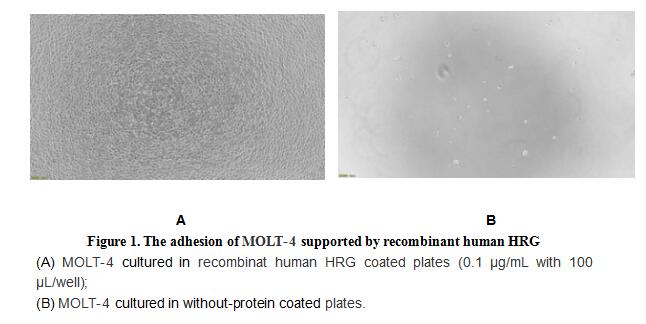Active Histidine Rich Glycoprotein (HRG) 

HPRG; HRGP; Histidine-Proline Rich Glycoprotein; Thrombophilia Due To Elevated HRG
- UOM
- FOB US$ 211.00 US$ 528.00 US$ 1,056.00 US$ 3,168.00 US$ 7,920.00
- Quantity
Overview
Properties
- Product No.APC534Hu61
- Organism SpeciesHomo sapiens (Human) Same name, Different species.
- ApplicationsCell culture; Activity Assays.
Research use only - DownloadInstruction Manual
- CategoryHematology
- Buffer FormulationPBS, pH7.4, containing 5% Trehalose.
- Traits Freeze-dried powder, Purity > 97%
- Isoelectric Point7.0
Sign into your account
Share a new citation as an author
Upload your experimental result
Review

Contact us
Please fill in the blank.
Activity test

Human histidine-rich glycoprotein (HRG) is a multidomain, monomeric, secreted, 67-75 kDa member of the cystatin superfamily of molecules. Its name derives from the fact that 26% of its amino acids (aa) are histidine and proline. In human, it is synthesized as a 525 aa precursor that contains an 18 aa signal sequence and a 507 aa mature region. Five distinct domains are recognized in the mature molecule. As HRG has the function of cell adhesion, we measure the activity of recombinant human HRG by the ability of the immobilized protein to support the adhesion of con-A activated MOLT 4 human acute lymphoblastic leukemia cells. When 1 x 105 cells/well with 7.5 ug/ml conA are added to recombinat human HRG coated plates (0.1 µg/mL with 100 µL/well), >70% cells will adhere after 2 hour incubation at 37 ℃. The adhesion of MOLT-4 after 2 hour incubation at 37 ℃ observed by inverted microscope was shown in Figure 1.
Usage
Reconstitute in 10mM PBS (pH7.4) to a concentration of 0.1-1.0 mg/mL. Do not vortex.
Storage
Avoid repeated freeze/thaw cycles. Store at 2-8°C for one month. Aliquot and store at -80°C for 12 months.
Stability
The thermal stability is described by the loss rate. The loss rate was determined by accelerated thermal degradation test, that is, incubate the protein at 37°C for 48h, and no obvious degradation and precipitation were observed. The loss rate is less than 5% within the expiration date under appropriate storage condition.
Increment services
-
 BCA Protein Quantification Kit
BCA Protein Quantification Kit
-
 Molecular Mass Marker for Protein
Molecular Mass Marker for Protein
-
 Monoclonal Antibody Customized Service
Monoclonal Antibody Customized Service
-
 Polyclonal Antibody Customized Service
Polyclonal Antibody Customized Service
-
 Protein Activity Test Experiment Service
Protein Activity Test Experiment Service
-
 Electrophoretic Mobility Shift Assay (EMSA) Experiment Service
Electrophoretic Mobility Shift Assay (EMSA) Experiment Service
-
 Buffer
Buffer
-
 Lentivirus Packaging Experiment Service
Lentivirus Packaging Experiment Service
-
 Adenovirus Packaging Experiment Service
Adenovirus Packaging Experiment Service
-
 Real Time PCR Experimental Service
Real Time PCR Experimental Service
-
 Spike RBD Protein (S-RBD)
Spike RBD Protein (S-RBD)
-
 Protein G
Protein G
-
 Protein A
Protein A
Citations
- Identification and Confirmation of Differentially Expressed Fucosylated Glycoproteins in the Serum of Ovarian Cancer Patients Using a Lectin Array and LC–MS/MSACS: pr300330z
- Evaluation of histidine-rich glycoprotein tissue RNA and serum protein as novel markers for breast cancerSpringer: Source
- The nuclear bile acid receptor FXR controls the liver derived tumor suppressor histidine‐rich glycoproteinPubMed: 25363753
- Pharmacokinetic and Pharmacodynamic Investigations of ION-353382, a Model Antisense Oligonucleotide: Using Alpha-2-Macroglobulin and Murinoglobulin Double-Knockout MicePubmed:27031383
- Compositions and Methods for Diagnosing Lung Cancery2016:0077095.html
- Combination of serum histidine-rich glycoprotein and uterine artery Doppler to predict preeclampsiaPubmed:29416108
- Ultrastructural Localization of Histidine-rich Glycoprotein in Skeletal Muscle Fibers: Colocalization With AMP DeaminasePubmed: 31880188
- Personalized Approach to Determination of Histidine-Rich Glycoprotein and E-Cadherin in Supernatants of Immunocompetent Blood Cells and Breast Biopsy …Pubmed: 32342301









